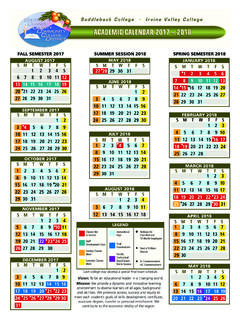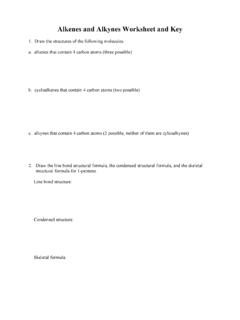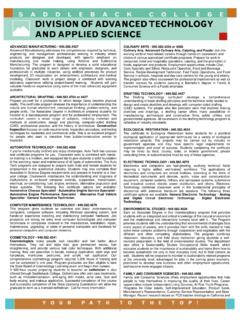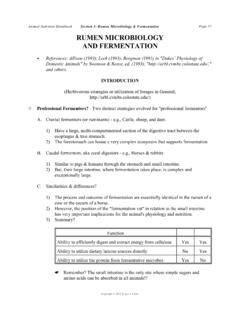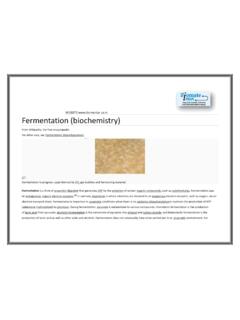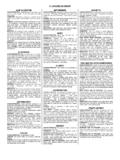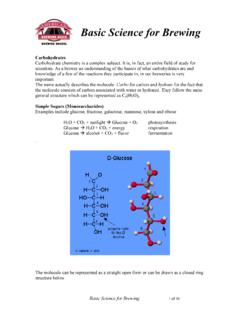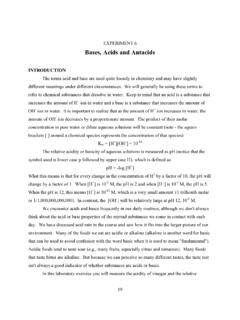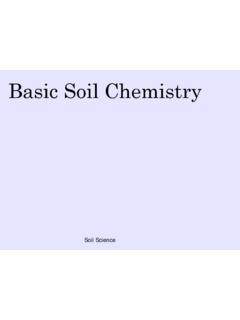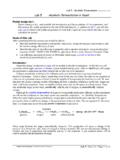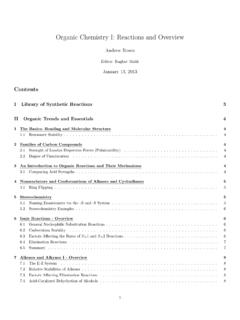Transcription of Chapter 12 Lecture Notes: Carbohydrates
1 chemistry 108 Chapter 12 Lecture notes Carbohydrates 1 Chapter 12 Lecture notes : Carbohydrates Educational Goals 1. Given a Fischer projection of a monosaccharide, classify it as either aldoses or ketoses. 2. Given a Fischer projection of a monosaccharide, classify it by the number of carbons it contains. 3. Given a Fischer projection of a monosaccharide, identify it as a D-sugar or L-sugar. 4. Given a Fischer projection of a monosaccharide, identify chiral carbons and determine the number of stereoisomers that are possible. 5. Identify four common types of monosaccharide derivatives. 6. Predict the products when a monosaccharide reacts with a reducing agent or with Benedict s reagent. 7. Define the term anomer and explain the difference between and anomers. 8. Understand and describe mutarotation. 9. Given its Haworth projection, identify a monosaccharide either a pyranose or a furanose.
2 10. Identify the anomeric carbon in Haworth structures. 11. Compare and contrast monosaccharides, disaccharides, oligosaccharides, and polysaccharides. 12. Given the structure of an oligosaccharide or polysaccharide, identify the glycosidic bond(s) and characterize the glycosidic linkage by the bonding pattern [for example: (1 4)]. 13. Given the Haworth structures of two monosaccharides, be able to draw the disaccharide that is formed when they are connected by a glycosidic bond. 14. Understand the difference between homopolysaccharides and heteropolysaccharides. 15. Compare and contrast the two components of starch. 16. Compare and contrast amylopectin and glycogen. 17. Identify acetal and hemiacetal bonding patterns in Carbohydrates . chemistry 108 Chapter 12 Lecture notes Carbohydrates 2 Introduction to Carbohydrates Carbohydrates are also known as_____.
3 Carbohydrates are an abundant biomolecule. More than 50% of the carbon in organic compounds is found in Carbohydrates Plants use photosynthesis to store energy in_____, a simple sugar 6 CO2 + 6 H2O + Energy C6H12O6 + 6 O2 Carbohydrates are a large class of naturally occurring polyhydroxy _____and _____. _____(also known as simple sugars) are the simplest Carbohydrates containing 3-7 carbon atoms. A sugar containing: an aldehyde is known as an _____ a ketone is known as a _____ Classification of Carbohydrates Carbohydrates are grouped into 3 classes: _____ are the simplest sugars and serve as the building blocks of larger molecules Example: Glucose _____ contain 2-10 monosaccharides bonded together (building block = residue) Example: Sucrose _____contain more than 10 residues Example: Complex Carbohydrates chemistry 108 Chapter 12 Lecture notes Carbohydrates 3 Monosaccharides Monosaccharides are _____ ketones or aldehydes with 3 or more carbons.
4 Naming Monosaccharides carbohydrate nomenclature is unique to sugar chemistry we do not name monosaccharides using the IUPAC rules. Monosaccharide names end in ose." Monosaccharides can be classified by: Carbonyl group: _____ or _____ _____ of carbons: triose, tetrose, etc. Both: aldotriose, ketotriose, and so chemistry 108 Chapter 12 Lecture notes Carbohydrates 4 Examples: You try it: Name each of the following monosaccharides as an aldose or ketose & according to its number of C atoms. _____ _____ _____ chemistry 108 Chapter 12 Lecture notes Carbohydrates 5 Stereoisomers in Carbohydrates Carbohydrates are _____molecules since they have carbon atoms carrying four different groups. The simplest three-carbon sugar is glyceraldehyde. This sugar exists as a pair of _____.
5 Enantiomers have the same _____ physical properties except they behave differently in the way they rotate polarized light and the way they are affected by catalysts. Remember: Compounds with n chiral carbon atoms has a maximum of 2n possible stereoisomers and half that many pairs of enantiomers (mirror images). The aldotetrose (below), has 2 chiral carbon atoms and a total of 22 = 4 possible stereoisomers (2 pairs of enantiomers). chemistry 108 Chapter 12 Lecture notes Carbohydrates 6 The D and L Families of Sugars: Drawing Sugar Molecules Fischer Projections represent three-dimensional structures of stereoisomers on a flat page. A chiral carbon atom is represented in the Fisher projection as the _____of two crossed lines. Bonds that point _____ the page are shown as horizontal lines. Bonds that curve _____ _____ _____the page are shown as vertical lines.
6 In a Fischer projection, the aldehyde or ketone carbonyl group of a monosaccharide is always placed toward the top of the page. chemistry 108 Chapter 12 Lecture notes Carbohydrates 7 Example: Glucose Monosaccharides are divided into _____ families: D form and L form sugars. D: the OH group on the chiral C furthest from the C=O comes out of the plane of paper and points to the_____. L: the OH group on the chiral C furthest from the C=O comes out of the plane of paper and points to the _____. chemistry 108 Chapter 12 Lecture notes Carbohydrates 8 Monosaccharides We will briefly survey some important pentoses and hexoses, and their derivatives. D-glucose, also called _____or_____ _____, is the most important monosaccharide in human metabolism. D-fructose, or fruit sugar, is most common natural ketose Honey is 40% fructose Monosaccharide Derivatives In _____ _____ a hydrogen atom replaces one or more of the -OH groups in a monosaccharide.
7 D-ribose and its derivative D-2-deoxyribose (deoxy = minus one oxygen atom) are found in various coenzymes and in DNA. chemistry 108 Chapter 12 Lecture notes Carbohydrates 9 Monosaccharide Derivatives (continued) In _____ _____an -OH group of a monosaccharide has been replaced by an amino (-NH2) group. D-glucosamine is an example. D-glucosamine is an amino derivative in which an amino group replaces one hydroxyl group In _____ _____the carbonyl group of a monosaccharide has been reduced to an alcohol group. o Sorbitol is an example. Sorbitol and Xylitol are used as sweeteners Ribitol is found in the coenzyme FAD chemistry 108 Chapter 12 Lecture notes Carbohydrates 10 Monosaccharide Derivatives (continued) In _____ _____ sugars, an aldehyde group of a monosaccharide has been oxidized to form a carboxyl group D-Gluconic Acid is an example.
8 Reactions of Monosaccharides Reactions of monosaccharides are reactions of carbonyl and hydroxyl groups ( Chapter 11). Aldehyde and ketone groups can be reduced Aldehyde and alcohol groups can be oxidized Reduction of Monosaccharides The reduction of the C=O group in an aldehyde or ketone produces _____ _____. Oxidation of Monosaccharides The oxidation of the aldehyde C=O group produces _____ _____ _____ . chemistry 108 Chapter 12 Lecture notes Carbohydrates 11 Oxidation of Monosaccharides (continued) Benedict s reagent is a copper compound that will oxidize only _____ _____ (aldoses) and not alcohols. A sugar that reacts with Benedict s solution is called a reducing sugar since it reduces the ion Cu2+ Cu+ NOTE: Some ketoses give positive results for Benedict s test because they _____ to aldehydes in the strongly basic Benedict solution.
9 chemistry 108 Chapter 12 Lecture notes Carbohydrates 12 Monosaccharides: Their Cyclic Form Review: A hydroxyl group in a monosaccharide can react with the carbonyl to form a _____ _____ Hemiacetals are made by the reaction of an _____with an _____. A hemiacetal contains a C atom bonded to an _____ and an _____group. A monosaccharide contains both an alcohol and an aldehyde group. It can react with _____ to form a cyclic hemiacetal. chemistry 108 Chapter 12 Lecture notes Carbohydrates 13 Open Chain to Cyclic Form Mechanism (MECHANISM NOT ON EXAM) Cyclic forms of monosaccharides are usually drawn with the Haworth Projection in which the ring is viewed from the side at an angle. The edge of the ring closest to the viewer is drawn with a bold line for perspective. Substituents on the ring in a Haworth projection are either up or down The pair of cyclic hemiacetals with the OH on the hemiacetal carbon in different positions are called _____.
10 For D-sugars, the -anomer has the OH pointing _____ For D-sugars, the -anomer has the OH pointing _____ chemistry 108 Chapter 12 Lecture notes Carbohydrates 14 Example: The open-chain form of D-galactose with its cyclic anomers. In solution, the open chain and cyclic forms of a monosaccharide are in_____: If we start with a pure open chain or cyclic form in solution, the optical rotation of the solution will change until equilibrium is achieved and the concentrations of the different forms remain constant. The change in optical rotation observed as the system approaches equilibrium is called _____. The cyclic forms of monosaccharides can be named as derivatives of the heterocyclic ethers furan (5 members) and pyran (6 members). chemistry 108 Chapter 12 Lecture notes Carbohydrates 15 Example: The aldopentose D-ribose forms a cyclic _____ (the deoxy form is also shown below) chemistry 108 Chapter 12 Lecture notes Carbohydrates 16 Oligosaccharides Oligosaccharides are short polymers containing 2-10 monosaccharide _____.
